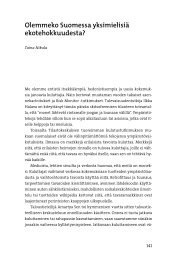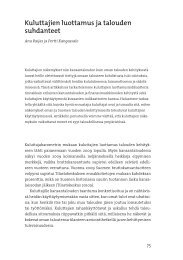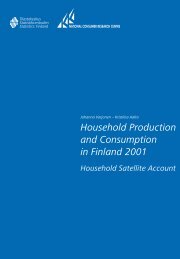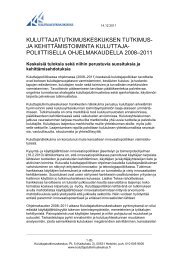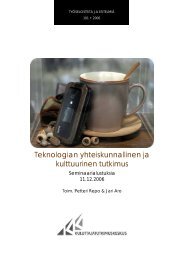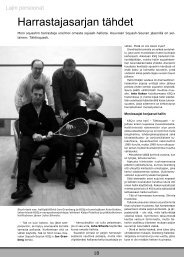Household Production and Consumption in Finland 2001
Household Production and Consumption in Finland 2001
Household Production and Consumption in Finland 2001
You also want an ePaper? Increase the reach of your titles
YUMPU automatically turns print PDFs into web optimized ePapers that Google loves.
Table 9.<br />
Percentage of household types <strong>in</strong> <strong>in</strong>come qu<strong>in</strong>tiles<br />
Q1 Q2 Q3 Q4 Q5 <strong>Household</strong>s<br />
<strong>in</strong> population<br />
S<strong>in</strong>gle-person<br />
households<br />
under 45 yrs 26 17 17 5 1 13<br />
45–64 yrs 1916 12 6 2 11<br />
65 yrs or over 40 194 1 0 13<br />
Couples without<br />
children whose<br />
reference person<br />
under 45 yrs 3 6 914 9 8<br />
45–64 yrs 2 5 14 21 24 13<br />
65 yrs or over 1 16 14 6 3 8<br />
Families with<br />
children, with<br />
one parent, youngest child<br />
0–17 yrs 5 6 4 1 1 3<br />
two parents, youngest child<br />
0–6 yrs 1 5 10 21 17 11<br />
two parents, youngest child<br />
7–17 yrs 1 2 7 14 28 10<br />
Other households 2 7 911 15 9<br />
% 100 100 100 100 100 100<br />
<strong>Household</strong>s were also grouped <strong>in</strong>to <strong>in</strong>come qu<strong>in</strong>tiles accord<strong>in</strong>g to gross<br />
household <strong>in</strong>come. Table 9 shows how different household types break down<br />
<strong>in</strong>to the five <strong>in</strong>come qu<strong>in</strong>tiles formed. It seems that the age of the reference<br />
person <strong>and</strong> the number of <strong>in</strong>come-earners have an <strong>in</strong>fluence on the <strong>in</strong>come<br />
qu<strong>in</strong>tile to which a household belongs.<br />
The lowest <strong>in</strong>come qu<strong>in</strong>tile seems to consist almost exclusively of people<br />
liv<strong>in</strong>g alone. In the second <strong>in</strong>come qu<strong>in</strong>tile, too, s<strong>in</strong>gle-person households <strong>and</strong><br />
pensioners make up the majority. The biggest group <strong>in</strong> the third <strong>in</strong>come<br />
qu<strong>in</strong>tile are young people liv<strong>in</strong>g alone as well as couples over 45. The fourth<br />
<strong>in</strong>come qu<strong>in</strong>tile consists primarily of childless couples of work<strong>in</strong>g age <strong>and</strong><br />
two-parent families with children. The fifth <strong>in</strong>come qu<strong>in</strong>tile differs from the<br />
previous qu<strong>in</strong>tile <strong>in</strong> that <strong>in</strong>stead of younger couples, it has a larger number of<br />
adult households, i.e. other households, <strong>and</strong> furthermore the proportion of<br />
families with school-age children is much greater than <strong>in</strong> the fourth <strong>in</strong>come<br />
qu<strong>in</strong>tile.<br />
48 Statistics F<strong>in</strong>l<strong>and</strong> National Consumer Research Centre




